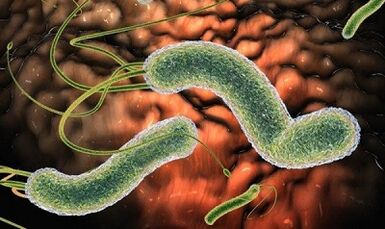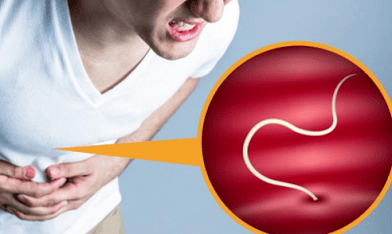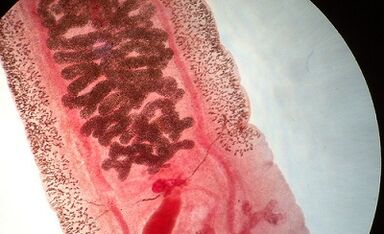
In patients, a serious misunderstanding is that helminths only live in the intestine.However, one cannot deny the fact that parasites in human blood are as wide as other types of helminthia.The identification and timely therapy of such pathological states require special attention, since a small socket can meet absolutely any organ when it comes into the bloodstream.
Symptoms and painful sensations that cause worms in the blood in humans can vary both in manifestations and in the degree of their severity.It is important to start treatment in good time and prevent the further spread of parasites to the human body in order to prevent complex consequences in good time.At first it is necessary to find out how worms appear in the blood.
Types of parasites set the bloodstream
Nothing is so much complicated by producing the correct differential diagnosis as an enormous spread of the symptoms that manifest themselves in the blood in patients with parasites.Different types of helminths cause different characters.In the case of worm infection with blood or blood vessels, the patient must be subjected to a complete medical examination, which helps to identify the type of parasite and to determine the appropriate treatment of the pathological state.
There are a number of parasites that can live in human blood:
- Babesia;
- Malaria plasmodium;
- Tripanosoma;
- Ankylostoma;
- Trichinella;
- Toxoplasma;
- Toksokara.
Most helminths appear in the human body after an insect bite.Such parasites of the circulatory channel are most dangerous for children.They influence the proper development of organs, the growth of the entire organism and the condition of the immune system.Many people can live with parasites for years and do not even suspect that they are infected.
General symptoms of parasitic blood poisoning
Every single type of parasite in human blood has symptoms that are only characteristic of this disease.
However, there are a number of characters that are characteristic of any kind of helminthosis:
- Weakness;
- Dizziness, headache;
- Nausea, vomiting;
- It is possible to increase the total body temperature.
- Pain in the limbs and throughout the body;
- Consciousness attacks are possible.
All of these symptoms are the main manifestations of the increased content of toxic substances in the body.In the first case, it is necessary to contact a medical facility in which doctors carry out all the necessary tests and diagnostic procedures that determine the cause of such a state most precisely.
Babesiosis: symptoms, diagnosis and treatment
Babesia are small parasites that penetrate the human body after an ixodic tick.These simplest organisms quickly penetrate into the erythrocyte membrane inside and start their difficult life cycle.The disease is often used in warm regions in which mites of the iXodes live.
In most cases, the disease takes place without obvious symptoms in both adults and children.
However, if the disease occurs and is further developed, the characteristic characteristics are determined:
- Hemolytic anemia;
- Fever to 39-40 degrees;
- Chills;
- Increased sweating.
Similar symptoms occur at least 4 weeks after the tick bite.After the incubation period, the likelihood of identifying the disease are much higher.
The disease can only be diagnosed under the conditions of specialized laboratories.For this reason, there is not so much data to spread the disease and its symptoms.
However, the applicable doctor should take a number of measures to identify pathogenic extraterrestrial active ingredients in the patient's body:
- general blood test;
- Serological tests for antibodies against women;
- Polymerase chain reaction;
- Microscopic examination of the blood line (coloring by hyme).
Treatment is mainly used with anti -protozoal medication.As a rule, the course of taking such funds does not take longer than 10 days, but can continue in patients with a recurring form of the disease.Asymptomatic patients are treated only if the cause of the babusiosis during the re -analysis is demonstrated in the blood that is carried out a few months after the first detection when the disease present was recurring.
Tripanosomosis: symptoms, diagnosis, treatment

Tripanosomosis, or so -called sleepy disease, is widespread in countries in tropical and subtropical climate and rarely occurs in moderate widths.The disease disease is a tripanosome.This is a small parasite.After viewing the photo of the parasite made with an electron microscope, you can differentiate between flagella and a membrane along the entire length of the simplest body.
The disease and their symptoms develop in two full stages.In the first stage, the parasite penetrates human red blood cells and begins its active reproduction.
This phase can be recognized using the following characters:
- Fevering attacks up to 7 days;
- Headache, weakness;
- Joint pain and limbs;
- Serious itching;
- The appearance of red dishacks in the area inflamed lymph nodes.
In the second stage of the disease, the tripanosome penetrates the central nervous system through the hematocenic phale barrier.This stage is characterized by serious impairment of the sleep and wax cycle - the main symptom of the disease.
In addition, the patient can occur in the second stage of sleepy diseases:
- blurred awareness;
- Muscle tremors, weakness;
- paralyzed limbs;
- Apathy;
- Irritability;
- Aggression in relation to others.
It is necessary to start treatment as soon as possible, otherwise it is not the cheapest result.The disease leads to the occurrence of organ failure of several body systems at the same time, the consequence of the patient's death.
The diagnosis of a sleepy disease is based on the patient's symptoms and microbiological examinations for tripanos in the blood, the lymph and the astrigy fluid from SHANCRA.The treatment is urgently prescribed in the event of positive samples.
A good forecast can be made if the disease can be detected in the hemolytic stage.At this point, rather toxic medication is prescribed, but in general the treatment by the patient's body is well tolerated.
However, if the disease can only recognize in the second stage, the forecast is not always soothing.In order to treat such a pathological state, it is necessary to use serious, toxic medication that can penetrate through the protective barrier of the central nervous system.
Malaria: symptoms and treatment

An infection with malarial plasmodium is done by a mosquito bite.Due to the salivary glands of the females, the parasite penetrates into the bloodstream of a person, is transferred to the liver with a blood flow, where the first stages of metamorphosis flows and then penetrate the bloodstream and influence red blood cells.
The incubation period of the disease takes up to 25 days.Then the first symptoms of malaria manifest themselves:
- a strong increase in body temperature;
- Headache, weakness;
- Hemolytic anemia;
- Yellowity of the skin;
- Nausea, vomiting;
- Pain of the joints, hurts throughout the body;
- Cramp of cramps;
- The occurrence of products of the destruction of red blood cells in the urine.
Basically, the disease is widespread in warm and hot regions, so that its diagnosis is only based on the symptoms and history of the patient's life, which was manifested over time.Frequent trips to equatorial countries can cause the development of the disease.In addition, standard blood tests and a microbiological examination of the body fluids are carried out.
The therapy is prescribed depending on the type of illness and its severity and is mainly carried out with antimaliaMedicaments.
Ankylostomosis: symptoms, diagnosis and treatment
The parasites that cause the disease live in the genes of the intestine and feed on the blood cells of the master's body.Worms penetrate through the skin of a person and start migration into the intestine.In the process of moving around the body, parasites with blood flow fall into the lungs and then give the bronchi in the trachea and in the upper airways, where they provoke a swallow reflex and thus reach the intestine, set on the walls.
In rare cases, worms of worms cannot successfully complete their migration and remain under the skin of a person.In the photo, a similar process is similar to small, thin snakes under the patient's skin.

The food of blood provokes the development of iron deficiency anemia in an infected person.The most dangerous when worms penetrate the children's body.The lack of iron, protein and other necessary components for the development of a child can cause mental disability, growth delay and physical inferiority.
The main symptoms of ankylosityomosis:
- Iron deficiency anemia;
- Fevering fits;
- Pain in the stomach;
- Nausea, vomiting;
- Diarrhea, constipation;
- Heavy loss of body weight;
- Coughing, infectious diseases of the upper airway during the migration of the parasite larval stages are possible.
The diagnostic measures differentiate between a general blood test, the analysis of feces and urine as well as an ultrasound examination of the digestive system.The identification of parasites becomes a good reason to start immediate treatment and prevention of pathological states in connection with the impairment of the respiratory, digestible and circulatory systems of the patient body.
Treatment is carried out by a one -time absorption of the Anhmint medicine.The therapy is supplemented by the use of vitamin and mineral complexes so that the consequences of a hemoglobin lack can be compensated for.
Toxocarosis: symptoms and treatment
The causal active ingredients of this disease are round helminths that a person can receive after longer communication with pets that have not been worn when eating unwashed vegetables and fruit.The human body becomes an intermediate host of the parasite.
Larvae climb into the intestine and hatch out of eggs and begin to "drill" the intestinal wall and penetrate into the bloodstream.With the blood flow, helminths migrate into a system of the human body.The result of the migration of worms is a serious impairment of the liver, the heart, the central nervous system and the organs of eyesight.

The main symptoms of an infection of the body toxocracles:
- Increase the total body temperature;
- The occurrence of severe pain in the stomach;
- Weakness, dizziness;
- the occurrence of an allergic rash on the skin;
- Strong cough at night;
- Cramps, muscles and joint pain.
The diagnosis of the disease is quite difficult.It is necessary to carry out serious microbiological, allergological tests for which a specialized laboratory is required:
- Polymerase chain reaction;
- Immunosorben analysis;
- Serological tests;
- Ultrasound examination of organs;
- Magnetic resonance and computer tomography.
Serious anhelmine therapy is only carried out if the patient's heart muscles are determined when serious damage to the brain is determined.The disease is very often independent, since the larval stage cannot develop into an adult individual in the body of a medium -sized host.
However, it is necessary to take into account the damage that migrating worms can cause the patient.It is necessary to carry out a supportive therapy and take the necessary measures to prevent the development of serious pathological processes in liver, cardiovascular and other organs.
Diploma
Parasites are dangerous for the human body.If questions arise, "which parasites live or use blood as a transport system", "how to correct it or not", "how to treat them and what to take", then it is best to contact a parasitologist and not make independent decisions.Treatment and prevention of parasitic diseases is a decision that a qualified doctor should make.





























